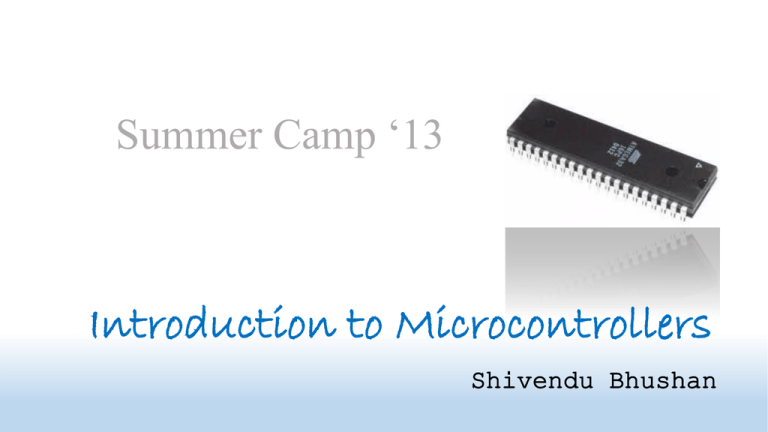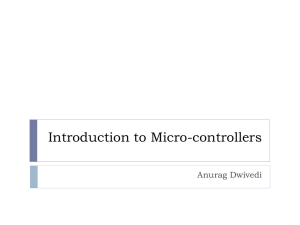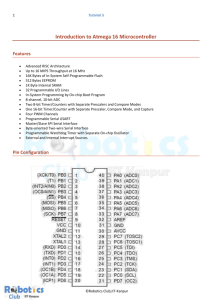Introduction to Microcontrollers
advertisement

Summer Camp ‘13 Introduction to Microcontrollers Shivendu Bhushan Embedded Systems • Gadgets and devices • Self controlled devices • Contains I/O devices, storage devices and a central ‘controller’ Example: Music player Input Output Controller Output Storage Device The Microcontrollers • Why “micro”? Larger controllers are available too: processors that run computers. • Out of several available vendors like Atmel, Intel, ARM, Cypress, etc. We will use Atmel ATmega microcontrollers. • Like computers they execute programs.We will use C as the coding language. Example: Atmega 16 • 40 pin IC. • 32 pins for I/O. • 8 pins reserved. • I/O pins divided into 4 groups of 8 pins, called ports. • Ports labeled as A, B, C and D. I/O Registers • Input / Output is controlled through special variables called “registers”. • Registers are actual hardware memory locations inside the μCs with predefined names and sizes. • Assigning a value to these registers in the program changes the corresponding hardware configuration. And, these values can be altered multiple number of time at any point in the program. • There are 3 registers that control the I/O pins: DDR, PORT and PIN. • Each port has it’s own registers. Hence, DDRA, PORTA, PINA registers for port A; DDRB, PORTB, PINB for port B and likewise. Registers DDR(Data Direction Register) • Decides whether the pin is Input or Output. • DDR is an 8 bit register. Each bit corresponds to a particular pin on the associated port. • If a bit on the DDR register is 0, then the corresponding pin on the associated port is set as input. • Similarly, if the bit is 1, then the pin is set as output. • If a pin is configured as input, then it has some floating voltage unless an external voltage is applied. • For an output pin, the voltage is fixed to a particular value. Setting Register Values • MSB of DDRA corresponds to the pin A7. • If DDRA = 0b10010110, then: PORT register • PORT is also an 8 bit register. The bits on the PORT register correspond to the pins of the associated port in the same manner as in the case of the DDR register. • PORT is used to set the output value. • If the pin is set as output, then a PORT value of 1 will set voltage at that pin to 5V, and PORT value 0 sets the voltage to 0V. • If the pin is configured as an input, PORT value serves the purpose of pull up or pull down. PIN register • PIN is a register whose value can be read, but cannot be changed inside the program. • It gives the value of the actual voltage at a particular pin. 1, if the value at the required pinis 5V and 0 for 0V. Summary Applications(Takneek/Techkriti) • Line Following Robots • Wireless keyboard • Wireless Gamepad • Tachometer • Music synthesizer • Motion sensing games How to program MCU ? ----CVAVR-----> ------------------------HOW ?--------------------> AVRSTUDIO #Problem: What kind of files MCU can execute ? #Problem: How to transfer that file to MCU ? Software needed: • CVAVR----> Editor and compiler • AVR Studio---- > Transfer the code to Atmega • ISIS--- > Circuit Simulator AVR Studio Select Tools Select Add STK500 Select AVR programming Select COM port Select Device -> Click Apply -> Read Device ID -> Read target Voltage -> Choose Hex File -> Then Program Thanks..!!











